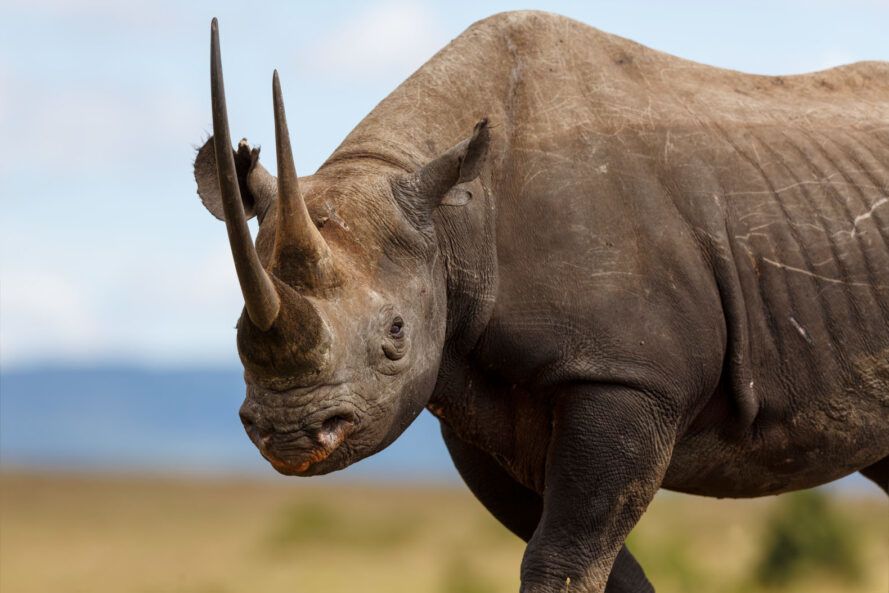
These 8 endangered animals are making a comeback
The animal kingdom is fraught with challenges, from predators to lost habitat and food shortages. While some species adapt to the changes, others suffer high casualties, driving dozens of animals onto the endangered species list. At the last report, the IUCN Red List of Threatened Species included 225 animals that are categorized as Critically Endangered.
Continue reading below
Our Featured Videos
However, through monitoring and habitat restoration, a handful of species are making a comeback. They give us hope that we can keep biodiversity thriving for the ongoing health of the entire planet.
Related: The very important key role tigers play to the ecosystem

Black rhino
Several species of rhino are threatened or endangered, and not all of them are faring as well as the black rhino. Declared extinct in 2011, the black rhino saw a massive decline due to poaching, sinking in numbers from 70,000 in 1970 to around 2,400 in 1995. However, conservation efforts have contributed to rising numbers, which now hover around 5,500. Although still listed as critically endangered, the numbers continue to increase and move away from the extinct classification.

Mainland eastern barred bandicoot
You likely don’t give this Australian marsupial much thought, but it’s been the focus of a 30-year effort to restore their habitat and control the numbers of the fox that nearly wiped them out. Happily, the mainland eastern barred bandicoot responded to efforts, allowing them to move to a classification of endangered, which is an upgrade from the previous classification of “extinct in the wild.” As a result, Zoos Victoria has halted its captive breeding program as they continue to monitor the species.

Steller sea lion
The Eastern distinct population segment of the Steller sea lion was listed under the Endangered Species Act in 1990. The species was delisted and designated as recovered 23 years later. The population continues to be monitored and protected in some areas.

Gray whale
Whalers nearly destroyed the gray whale population in the mid-1800s and early 1900s when whale blubber was used as fuel for oil lamps. Nearly extinct in 1950, the species became a focal point of many conservation efforts and protections. It worked, with numbers rebounding to nearly 20,000 in the mid-1990s when it was delisted from the endangered list.

Mountain gorillas
Once thought to be extinct, the numbers of mountain gorillas are slowly growing in Uganda and the Congo. The increase is gradual but notable. The 83,840-acre Bwindi-Sarambwe ecosystem is one of two places where the gorillas are known to call home. In 2011, researchers counted 400 of the species, which rose to 459 seven years later. In total, there are an estimated 1,063 in the world, a number that moved the animals from critically endangered to endangered in 2018.
The biggest threats come from humans in the form of habitat loss, poaching and disease transmission. But awareness goes a long way towards protecting these majestic creatures and growth is a positive indicator, no matter how slow. Current conservation efforts continue to expand the mountain gorilla territory.

Pemba flying fox
This animal is not a fox at all. The Pemba flying fox is actually a fruit bat; a huge one with a wingspan of 5.5 feet. Named after its only known home on Pemba island near Tanzania, the species was close to extinction in the late 1990s when deforestation altered its habitat.
It’s far from the only species that suffered the fate of the island. However, the Pemba flying fox plays its role in the ecosystem of other animals and hundreds of plants.
Following conservation efforts that began in 1995, the species made a significant recovery which resulted in the last few hundred bats expanding to over 20,000.

Wild Iberian lynx
The wild Iberian lynx is another animal that suffered the fate of changing habitats. With the loss of cork oak trees in their native Portugal, numbers dropped to an estimated 100 or less.
Through habitat restoration, 49,420 acres were protected, and over the course of two decades, the lynx were reintroduced to the region. Numbers then quadrupled to over 400. They were reclassified from critically endangered to endangered after an assessment in 2014.

Tigers in Nepal
The fate of tigers has been in the spotlight for decades. According to the World Wildlife Fund, a multi-country commitment to tiger recovery started in 2010, called TX2, vowed to double the number of tigers by 2022. Nepal is the first country nearing the finish line on that goal as numbers continue to rise. Starting with a baseline of 121 tigers in 2009, the population reached an estimated 235 in 2018. Most recently, Nepal’s National Tiger and Prey Survey 2022 found that the number had grown to 355.
While the large animals seem to get the most attention during discussions about the endangered species list, there are hundreds of animals that need help. You can get involved through the World Wildlife Fund, a local wildlife organization or by getting involved in habitat restoration in your area.
Via USA Today, World Wildlife Fund, National Geographic, IUCN Redlist, CNN
